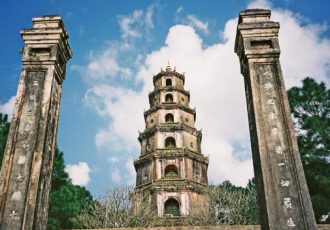About this royal tomb
Tự Đức’s tomb is the most representative monument of the Nguyễn Dynasty architecture and also one of the most wonderful constructions of the 19th century. First of all, before the death of Tu Duc, this monument was a palace, the 2nd residence of the emperor. The poet emperor Tu Duc (1848-1883) decided to build it to entertain himself and to prevent an unexpected death. Every footprint in this complex marks the romantic spirit of a talented emperor.
Tu Duc’s Tomb, also known as KhiêmLăng, is a remnant of the Hue Monument Complex. It is the final resting place of the 4th Emperor of the Nguyen Dynasty, Emperor Tu Duc (Nguyen Phuoc Hong Nham). He reigned for 36 years, from 1847 to 1883, the longest reign of the Nguyen Dynasty.
Emperor Tu Duc chose a romantic piece of land to enjoy his last sleep. His tomb is located on a narrow valley in Duong Xuan Thuong village, Hue.
The building history
Tu Duc Tomb has several names attached to each period of his history. The work began in 1864 with the participation of 50,000 soldiers. At that time, the tomb played the role of the second residence of Emperor Tu Duc and was named “Ten Thousand Years” (Van Nien Co). To finish the project on time (for 6 years), one hundred thousand labourers and workers had to work painfully from dawn to midnight. Their lives were infinitely difficult: insufficient food, torn clothes, injuries often caused by the whip… This forced labour provoked the anger of the people. The people passed on a lament:
“How do Ten Thousand Years go?
Walls of soldiers’ bones, trenches of people’s blood.”
After two years, the population could no longer stand the suffering, so the builders rose up. Historical documents gave this uprising the name “The Lime Pound Rebellion” because the workers used lime pestles as weapons and attacked the Hue Citadel. But the uprising failed and ended in a sea of blood. After this disturbance, Emperor Tu Duc renamed the tomb to the “Palace of Modest” (Khiêm Cung).
The Modesty Palace was completed in 1873. When Emperor Tu Duc died in 1883, the palace was renamed “The Tomb of Modesty”.
Scale and Structure
Because of the accession to the throne during a time of turmoil and a tiring private life without children, Emperor Tu Duc followed the faith in life after this death. He built his tomb with effort. In the end, the area of Tu Duc’s tomb was about 120,000 square meters, 10 times larger than the tomb of Gia Long (the founder of the Nguyen Dynasty)!
Tu Duc’s tomb includes about 50 large and small monuments. Their names bring the word “Modesty” (Khiêm).
The resident palace area
– Vu Khiêm Gate: the entrance to Tu Duc’s tomb
– Chi Khiêm House of Worship: house of worship of Tu Duc’s women. Located on the left.
– Luu Khiêm Lake: In the past, it was a stream that flowed through this area. After its enlargement, it took the form of a lake. It has a significance of geomancy, Yin-Yang balance and Five Elements. It was used to gather luck and plant lotus flowers.
– TinhKhiêm Island: in the middle of LuuKhiêm Lake. It was a place where flowers were planted and rare animals were raised.
– XungKhiêm and Du Khiêm Pavilions: on LuuKhiêm Lake. Here the emperor looked at flowers, wrote poems, read books…
– Tuan Khiêm, Tien Khiêm and Do Khiêm bridges: path to the pine hill
– The gate of the Palace of Modesty (Khiêm Cung Môn): a two-storey lookout behind the lake of LuuKhiêm. Passing through the gate separating from the lake, it is the dwelling of the emperor
– HoaKhiêm Palace: formerly, it was the office of Emperor Tu Duc. Today, it is the house of worship of Tu Duc and his queen.
– PhapKhiêm Vu and Le Khiêm Vu: located on both sides of HoaKhiêm Palace. These are the rooms of the mandarins when they came here.
– Luong Khiêm Palace: behind HoaKhiem Palace. Tu Duc’s room (formerly), the house of worship of Queen Mother Tu Du, the mother of Emperor Tu Duc.
– The House of On Khiêm: storage of the emperor’s objects, located to the right of Luong Khiêm Palace
– Minh Khiêm Theatre: one of the oldest existing theatres in Vietnam. It is located to the left of Luong Khiêm Palace.
– Tri Khiêm and Y Khiêm Rooms: the residences of the odalisques, the wives of Emperor Tu Duc
– The Tung Khiêm and Dung Khiêm Gardens: the sambar gardens
The mausoleum area: behind the palace area
Behind the Bái Pavilion and two lines of mandarin statues is the Stele Pavilion (Bi Đình) with a 20-ton stone stele. On this stele, was engraved “Memory of the Palace of Modesty” composed by the Tu Duc emperor. This document contains about 4,953 words, it is an autobiographical writing of the emperor about his life, his kingship, his misfortune and diseases, but also his merits and faults.



